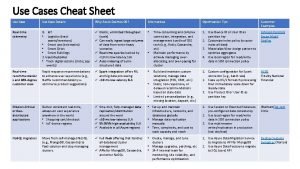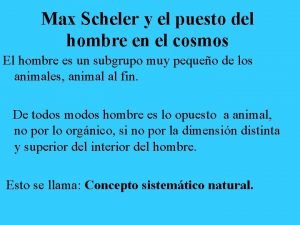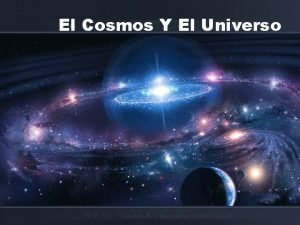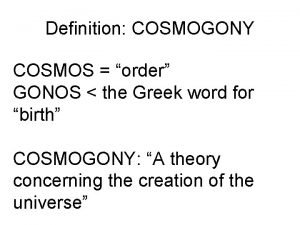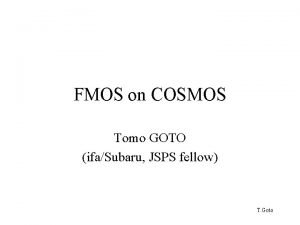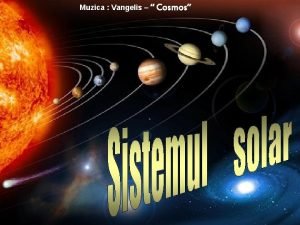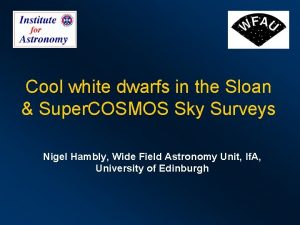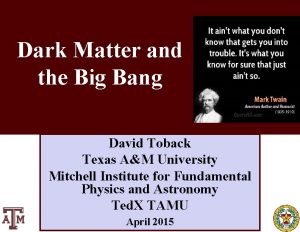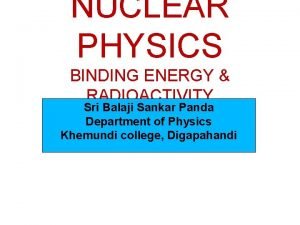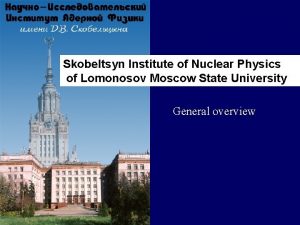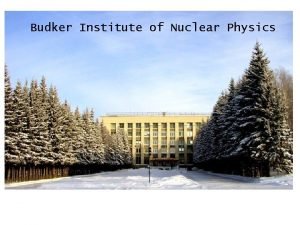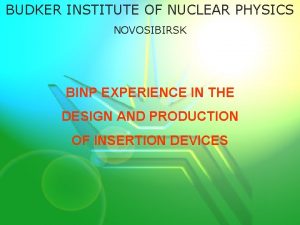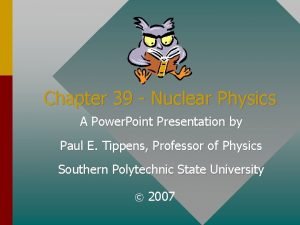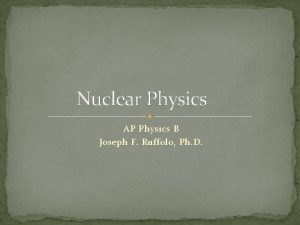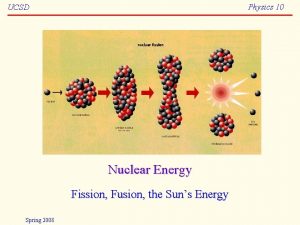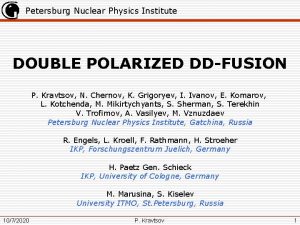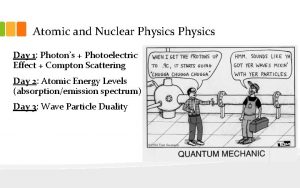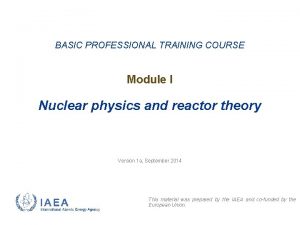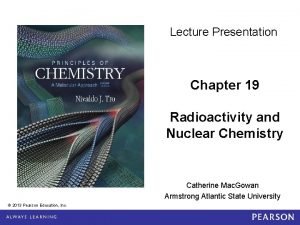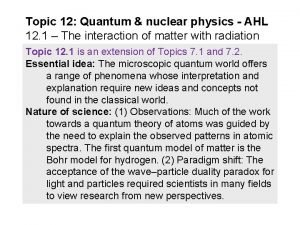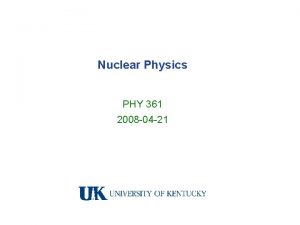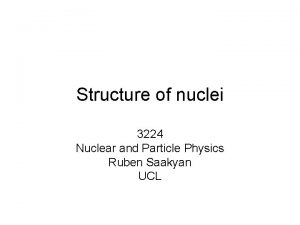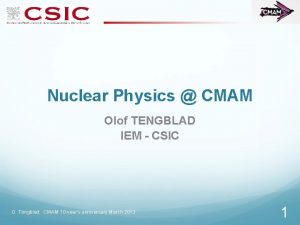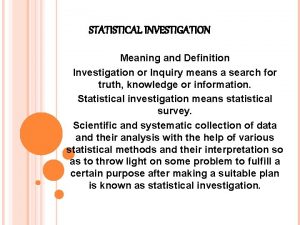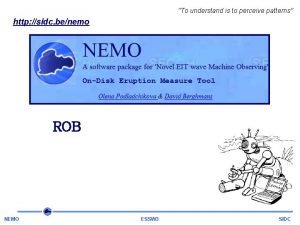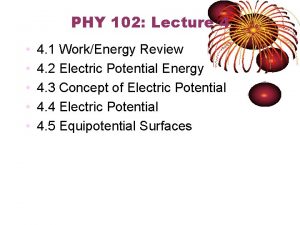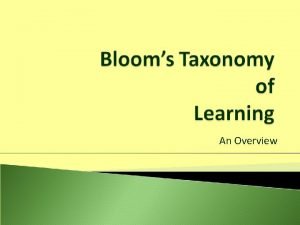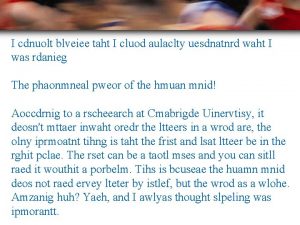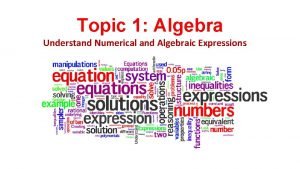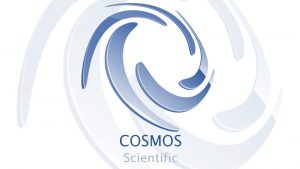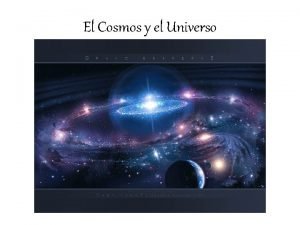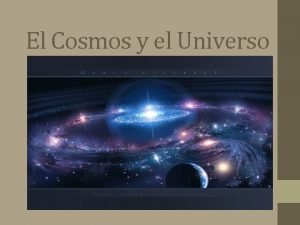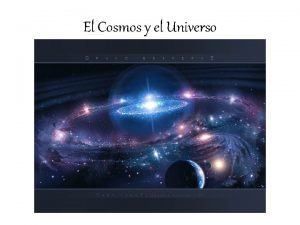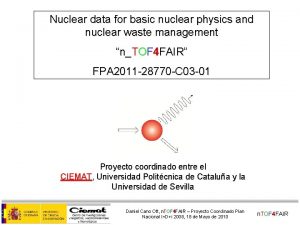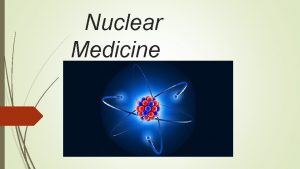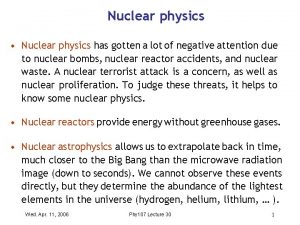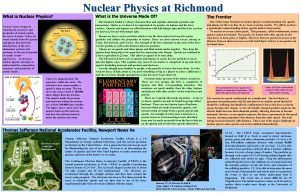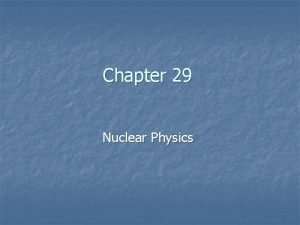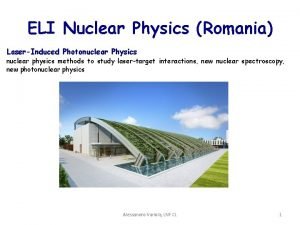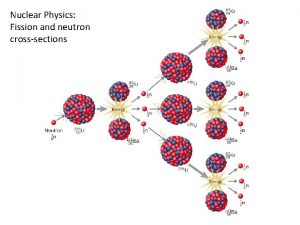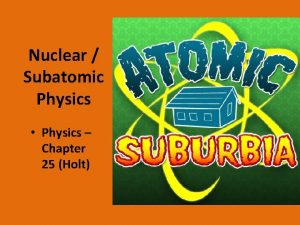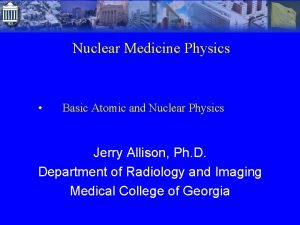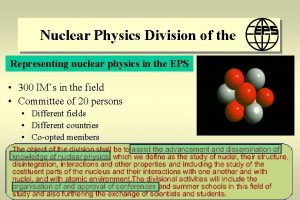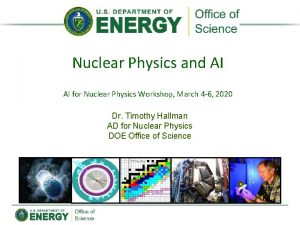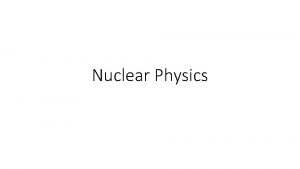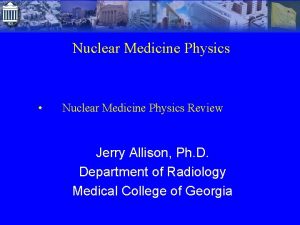Nuclear Physics in the Cosmos Understand nuclear processes











































































































- Slides: 107

Nuclear Physics in the Cosmos Understand nuclear processes that For background, see Power the stars Synthesize the elements Mediate explosive phenomena Determine Nature of stellar evolution Sites of astrophysical processes Properties of universe Neutrino properties http: //www. nscl. msu. edu/~austin/ nuclear-astrophysics. pdf

An Intellectual Opportunity This is a special time • Wealth of new astronomical observations--require new nuclear data for a credible interpretation • New accelerators of radioactive nuclei to provide this data • Growing computational power to simulate the phenomena

Cosmic History—a Long View Universe began as a hot, sense primeval fireball-Big Bang It then cooled: T 1/t 1/2 Light elements were made Galaxies and stars formed TEMPERATURE (K) Creation of matter Elementary particles 1020 TI M E 1010 Light elements NU CL E 1 10 -10 quark/gluon hadron Stars AR PH 3 o 1010 years YS I CS Now 10 -20 1020 1040 TIME AFTER BIG BANG (seconds)

Outline of the Lectures: The observables: Cosmic abundances, abundances in the solar system and elsewhere Nature of the nuclear processes involved: • Reaction rates • Resonant and non-resonant processes • Technical details: Gamow peak, S-factor, etc. The Big Bang and the Nature of the Universe Baryons, dark matter, dark energy Stellar evolution with some digressions • Quasistatic evolution, solar neutrinos, s-process , stellar onion • Explosive phenomena: supernovae, r-process, neutrinos • Binary systems: x-ray bursters and x-ray pulsars, the surface of neutron stars.

Outline-Continued What nuclear physics do we need to know? • Throughout the presentation • Theoretical and experimental needs, and their coordination with astrophysicists Nature of experiments at low and high energy facilities • High energy approaches to low energy astrophysics • The NSCL--an extant fast-radioactive-beam-facility • The proposed RIA facility

the 3 rd minute cataclysmic binaries stellar evolution Nuclear Astrophysics Supernovae AGB stars Origin and fate of the elements in our universe Origin of radiation and energy in our universe

Some Quotes to Keep in Mind Simplicius (Greek 6 th AD) on ideas of Leucippus (5 th BC): “The atoms move in the void and catching each other up jostle together, and some recoil in any direction that may chance, and others become entangled with on another in various degrees according to the symmetry of their shapes and sizes and positions and order, and they remain together and thus the coming into being of composite things is affected. ” King Lear, Act IV, scene 3: “It is the stars, the stars above us govern our condition” Arthur Eddington, 1928 I ask you to look both ways. For the road to a knowledge of the stars leads through the atom; and important knowledge of the atom has been reached through the stars” Mark Twain, Life on the Mississippi “There is something fascinating about science. One gets such wholesale returns of conjecture out of such a trifling investment of fact. ” Willy Fowler: “We got to get all this theory out of things”.

Cosmic Abundances (Really solar system, mainly) Log Abundance A qualitative view-Suess-Urey Plot • Very large range of abundances • Names denote various creation processes Group Mass Fraction 1, 2 H Neutron Captures A 3, 4 He Li, Be, B CNO Ne Na-Sc A=50 -62 A=63 -100 A>100 0. 71 0. 27 10 -8 2 x 10 -2 2 x 10 -3 2 x 10 -4 10 -6 10 -7

A More Detailed Picture Solar abundances all processes Rapid n capture process Makes most of Gold and Platinum Makes Uranium

Populations I, II and III What about elsewhere? In the halo of the galaxy find (old) stars (Pop II stars) with small abundances of metals (A > 4) compared to the solar system values typical of Pop I stars. Pop II stars • Reflect processes in the early galaxy • Investigation of Pop II stars is a hot area of astrophysics What are Pop III stars? • Stars that produce the material from which Pop II are made. • Probably very large (> 100 Msun) fast evolving stars made from products of the Big Bang.

The Stars as Element Factories Stars Nuclear Reactions Element Synthesis Supernova remnant N 132 D-LMC Condensation Ejection-Supernovae Planetary nebulae Interstellar Gas Dust Star Forming Region DEM 192 -LMC

Back to the Big Bang Universe began as a hot, sense primeval fireball-Big Bang It then cooled: T 1/t 1/2 Light elements were made Galaxies and stars formed TEMPERATURE (K) Creation of matter Elementary particles 1020 TI M E 1010 Light elements NU CL E 1 10 -10 quark/gluon hadron Stars AR PH 3 o 1010 years YS I CS Now 10 -20 1020 1040 TIME AFTER BIG BANG (seconds)

Element Production in the Big Bang Assumptions: • General relativity • Universe isotropic, homogeneous • Tnow= 2. 735 K (CBR)) Production of elements • 10 -300 sec after BB • T 1010 K, 1 g/cm 3 • Big Bang produces only 1, 2 H, 3, 4 He, 7 Li • Yield depends on density B of baryons Reaction network Need to know noted reactions= Poorly known reactions

Can we Determine the Baryon Density from the Big Bang? Method • Find B where predicted and observed abundances equal. • If B same for all nuclides, it assume it is the universal density Result OK, EXCEPT for 7 Li. Perhaps predicted abundance wrong (poor cross sections) or primordial Li higher (star destroyed). Nollett and Burles, PRD 61, 123505 (2000)

It’s Close, Why Does It Matter? Era of precision cosmology Cosmic Background Radiation • Far reaching conclusions • Surrounds us, Planck distribution must be checked and the (T~2. 7 K), remnant of early BB value of B is the best • Fluctuations (at 10 -5 level) give possibility. information on total density of Universe and on B. • Need more accurate cross sections for several It implies 7 Li. reactions affecting Universe is just bound Wtot =1 • Baryon density r. B ~ 0. 05 • Dark matter density, r. D ~ 0. 3 perhaps WIMPS, weakly interacting massive particles • Dark energy r. L ~ 0. 65

What energy source powers the stars? All energy comes from mass Of the possibilities f chemical 1. 5 x 10 -10 2200 yrs f gravity 107 yrs f nuclear 0. 007 1011 yrs Only nuclear remains Other evidence Must provide solar luminosity for >4. 6 x 109 yrs L sun = 3. 826 x 1033 erg/sec M sun = 1. 989 x 1033 g Technetium is seen in stellar spectra. BUT the longest lived isotope is unstable--lifetime of 4 x 106 yrs. Must have been synthesized in the star.

Reaction Rates and Energy Scales Environment Reaction Rate • Ionized gas (plasma) with Ni • k = 8. 6171 x 10 -5 e. V/K • T = 107 -1010 K k. T=1 -900 ke. V /cm 3 of species “i” • Assume species x moving at • Coulomb barriers Me. V range velocity v through species y at • Reactions are far sub-coulomb rest. Rate of reactions rxy is rxy = Nx. Nyv xy Einc • Average over velocity distribution (Max. Boltz. ) } rxy = Nx. Ny(1+dxy)-1<v xy> # of pairs/cm 3 Turning point xy(E) tunneling probability for point coulomb charge

Example Reaction – 7 Be(p, g)8 B Nature of Cross Sections S Factor = E exp(b/E 1/2) Increase Rapidly with Energy Removes penetrability, nearly constant away from resonance

What Energies are Important? S contains the nuclear structure information-At what energy do we need to determine it? Gamow Peak: Maximum in product of MB distribution and penetrability of Coulomb barrier E 0 = 5. 9 ke. V p + p 27 ke. V p+14 N 56 ke. V + 237 ke. V 16 O+16 O Cross sections at Eo too small to be measured

S for Resonant and Non-Resonant Phenomena Resonance in Gamow Peak dominates the rate • Rate Gp. Gg/(Gp+Gg)·exp(-Er/k. T) • Measure: Gs, Er Rate. Gs may be strong functions of E No resonance--Rate characterized by slowly varying S factor at low energy. • Classic expts. with low-E accelerators: small ’s at low-E • Measure cross sections to low-E, extrapolate to Eo to extract S-Factor. Role of High-E facilities • Long used for resonant rates, esp. Er • Recent emphasis on new techniques to measure non-resonant rates. Subject of this talk and several talks at this meeting.

Nature of Stellar Evolution How it looks! Image of Sun: Goddard Space Flight Center (http: //antwrp. gsfc. nasa. gov/apod/image/9709/ solprom 1_eit_big. jpg) T= How it works! Gravity pushes inward, but the center of the sun in heated by nuclear reactions, making a high pressure that pushes outwards. They balance, and the sun just sits there burning its nuclear fuel. This has gone on for 4. 5 billion years and will continue for another 5 billion years.

“Energy Production in Stars” A Scenario-H. A. Bethe (CNO Cycles) Physical Review 55, 103(L) 1939. One Page. One Nobel-1967 . . . for his contributions to theory of nuclear reactions, especially his discoveries concerning energy production in stars.

The pp Chains and Neutrino Sources Low E n. s

Observing the Center of the Sun with Solar Neutrinos Problem • Can’t look with telescopes • Light is absorbed in L, reemitted in random direction. • Drunkard’s walk: Distance covered = (N)1/2 L • N number of steps; • L length of a step. D Sun SUN Result: For sun, L = 0. 1 cm, D = 6. 96 x 1010 cm. Takes: 5 x 104 yr Look at emitted neutrinos • Made in solar cycle, escape without hindrance • N ~T 18, measuring flux measures T at center of sun But it’s hard s hardly interact • Need a huge detector

Solar Neutrino Spectra-Detector Thresholds , SNO

First experiment-R. Davis (1968) The Detector • 100, 000 gallons cleaning fluid (perchlorethylene C 2 Cl 4), Homestake gold mine, S. D. + 37 Cl e + 37 Ar - Inverse decay • Collect by bubbling He through tank (every 30 days)-count radioactive 37 Ar Motivation “To see into the interior of a star and thus verify directly the hypothesis of nuclear energy generation. ”

Implications of the Davis Experiment Results • Expected 2 37 Ar per day. Got 0. 5/day-a shocker! • “Solar neutrino problem”, a one-number problem • Solution in solar physics? nuclear physics? particle physics? • Motivated a search for the cause: 1968 to present • Better solar models, improved input nuclear physics. New Experiments-different neutrino energy sensitivities • Davis( Cl)-----8 B, 7 Be ne • Gallex/Sage (Ga)--p-p, 7 Be ne • SNO (D 2 O)-----8 B ne, nx • Super-K(H 2 O)------8 B ne, ( x) Others yet to come, see http: //www. sns. ias. edu/~jnb

The Super-Kamiokande Detector Japan, US, Korea, Poland Properties • 50, 000 tons H 2 O, 11200 P. M. s • 1000 m underground, Mozumi mine, Kamioka Mining Co. • Observe e-e scattering (mainly)-via Ĉerenkov light

SNO—The Sudbury Neutrino Detector Unique characteristics • 1000 tons heavy water (D 2 O) • See electron neutrinos and muon and tau neutrinos • Charged current (CC) e + D p + e- • Neutral current (NC) x + D x + p + n • x + e (ES) Location • 6800 feet under ground, Creighton mine Sudbury, Ontario. • Canada, US, UK

Solar Neutrino Experiments--Summary Standard solar model vs. Expt. Bahcall and Pinsonneault, 2000 It appears: different fractions of neutrinos arrive at the detectors • All of p-p ’s • ~0. 5 of 8 B ’s • Few of 7 Be ’s As compared to the standard solar model Note: SNO differs from S-K because SK sensitive to x

How might this happen Flaws in the physics input? Neutrino oscillations • Stellar physics--no, details • Neutrinos have mass. Oscillate to be settled. A check from into another type of neutrino. Helioseismology ( e m) • Nuclear Physics--no, but • Detector not sensitive to these better prediction of fluxes neutrinos needed. • Probability of survival: P(ne ne) • Properties of neutrinos--the • P(ne ne) =1 -(sin 2 V) sin 2(a. Dm 2 d/E) consensus culprit • Dm 2 = (m 12 -m 22) • Passage through matter changes the constraints-resonant conversion.

Determining Dm 2 and V Survival Probability • Show two cases: large mixing angle (now favored) and small mixing angle. • Analysis is complex and subtle Example • Extracted values depend on reaction rates for • 7 Be(p, g)8 B, (S ) 17 • 3 He( , g)7 Be • H. Schlattl, et al. , PRD 60, 113002 (1999)

Neutral Currents from SNO First results (with S-K) • Ascribe difference in SNO CC rate ( e) and SK ES rate ( e + x) to x • Extract x –agrees with Standard Solar Model (SSM) New from SNO Combine all three SNO detection modes CC, NC, ES Results • ( e) = 1. 76 x 106 cm-3 sec-1; ( m + t ) = 3. 41 x 106 cm-3 sec-1 • Good agreement with SSM- solar neutrino problem is no more

Need Better Nuclear Data Why • Explanation of solar neutrino problem is still imprecise • Extracted values of Dm 2 and V depend on the cross sections for certain nuclear reactions Important cases • 3 He( , g)7 Be • 7 Be(p, g)8 B, (S ) 17

How the Sun Evolves Core hydrogen burning ends • Consumed central 10% of sun • No heat source, pressure decreases, gravity wins • Core collapses, releases gravitational energy which heats the core Core helium burning starts • Core hot-allows fusion of two a’s (Z=2) • Helium fuses to 12 C, 16 O • Hydrogen burns in shell He Burning Core T=108 K r = 104 g/cm 3 H burning shell Non-burning envelop

What’s next for the Sun? It’s the end of the line • Helium burning ends after 108 years, C and O core • Gravitational collapse, BUT, never reach sufficient T to fuse C + C. • Collapse continues to 107 g/cm 3 --electron pressure stops collapse • Shells still burning, unstable, blow off planetary nebula Star becomes a white dwarf (e. g. Sirius B). Property Earth Sirius B Sun Mass (M sun) 3 x 10 -6 0. 94 1. 00 Radius(R sun) 0. 009 0. 008 1. 00 Luminosity(L sun) 0. 0028 1. 00 Surface T (K) 287 27, 000 5770 Mean r (g/cm 3) 5. 5 2. 8 x 106 1. 41 Central T (K) 4200 2. 2 x 107 1. 6 x 107 Central r (g/cm 3) 9. 6 3. 3 x 107 160 Ring nebula in Lyra. NGC 6720—a planetary nebula

The Evolutionary Process for Heavy Stars With this background can guess what happens for heavier stars

Heavy Stars--The Stellar Onion Starts like the sun: He Burning Core T=108 K = 107 kg/m 3 The Result Non-burning H H He C O But now, when He is exhausted in the core and the core collapses, it does get hot enough to burn carbon and oxygen. The successive stages in the core are H He, gravity, He C, O, gravity, C, O Mg, Si, gravity, Si Fe. Magnesium Silicon Attention !!! Iron (Fe)

Supernovae Core Collapse Fe (Iron) is special Core of Time our stellar onion is “Fe”, most tightly bound nucleus. Result of fusing two “Fe's” is heavier than two “Fe's”; costs energy to fuse them. No more fusion energy is available. Core collapses, keeps on collapsing, until reach nuclear density. Then nuclei repel, outer core bounces. Outgoing shock wave forms "Fe" core Collapse Bounce--Form Shock Wave Shock moves out, Fe p's , n's in outer part of Fe core

Evolutionary Stages of a 25 Msun Star Weaver et al. , 80 Burning Stage H He C Ne O Si Core collapse Core Bounce Explosive Time Scale 7 x 106 y 5 x 105 y 600 y 1 y 0. 5 y 1 d Seconds Millisec 0 -1 -10 sec T(K) x 109 0. 006 0. 23 0. 93 1. 7 2. 3 4. 1 8. 1 34. 8 1. 2 -7. 0 r (g/cm 3) 5 700 2 x 105 4 x 106 1 x 107 3 x 109 3 x 1014

What Next? We know that 1 -D model (T. Mezzacappa) • Shock blows off outer layers of star, a supernova • 1051 ergs (1 foe) visible energy released (total gravitational energy of 1053 ergs mostly emitted as neutrinos). Theoretically • Spherical SN don’t explode • Shock uses its energy dissociating “Fe”, stalls • Later, ’s from proto-neutron star deposit energy, restart the shock. Still no explosion.

The Question—How do we get from here to an explosion? SN 1987 a in Large Magallanic Cloud

Non-Spherical Calculations Two views Is sphericity the problem? • Now have 3 -D calculations which explode, but have only a part of the detailed microphysics. Their stability against such changes is not known— we return to this later. • See, e. g. C. Fryer and M. Warren, Red upwelling Astrophysical Journal, 574: L 65 -L 68 Blue sinking • Find 2 -D, 3 -D similar

What’s Produced in a Supernova Model • Evolve the Pre-SN star • Put in a piston that gives the right energy to the ejecta (Don’t know how explosion really works). • Calculate what is ejected • Calculate explosive processes as hot shock passes. Find • Example: Wallace and • Elements, mass 20 -50, generally Weaver, Phys. Rep. reproduced at same ratio to solar. 227, 65(93) • Modifications by explosive processes are small

12 C(a, g)16 O—an Important Reaction Helium Burning- A two Stage Process • 3 : + 8 Be* + 12 C* 12 C (gs) Rate known to ± 12% • 12 C( , g)16 O Poorly known (20 -30%) • Ratio affects 12 C/16 O after He burning—important resulting effects Mass of Pre-SN Cores Core masses Element Synthesis in SN r 3 a

Some important Nuclear Rates for SN Synthesis 12 C(a, g)16 O • r 3 = 170 ± 20 ke. V-b (300 ke. V) describes abundances (last slide) • Experiment: 100 -200, preference near 150, but uncertain. • High priority reaction 12 C + 12 C for Carbon burning 22 Ne(a, g), 22 Ne (a, n) Production of light slow neutron capture (s-process) nuclides--A= 60=88 Weak decay rates for gamma line emitters. E. g. 60 Fe Charged particle reactions on N=Z nuclei for production of pprocess nuclei For more details R. Hoffmann et al. UCRL-JC 146202 and many references at: http: //www. ucolick. org/~alex/ nucleosynthesis/

Weak Strength and Supernovae Core Collapse Gamow-Teller (GT) Strength? • Mediates -decay, electron capture(EC), induced reactions GT (allowed) Strength S=1; L = 0, e. g. 0+ 1+; GT+, GT Lies in giant resonances; Situation After silicon burning, Tcore 3. 3 x 109 K, density 108 g/cm 3. e- Fermi energy allows capture into GT+. At higher T, GT+ thermally populated, - decays back to ground state. - E. C. GT+ dominates the processes B(GT) (n, p) (p, n)

How Weak Strength Affects the SN Core size depends on Ye= <Z/A> Starts near 0. 5 Reduced by electron capture As Ye decreases, - decay becomes important. Competition of EC and - stabilizes Ye near 0. 45 When EC and - compete we have the possibility of a cyclic process-the URCA process. Urca process (named after a Casino da Urca in Rio de Janeiro that takes your money slowly but surely) ZA + e- Z-1 A + Z-1 A ZA + e- + Net result: production of two neutrinos removes energy from the core T reduced

Effects of Changed Weak Rates-Heger et al. Ap. J. 560 (2001) 307 Compare WW, LMP rates • WW standard Wallace. Weaver rates • LMP-from large basis shell model calculations. Langanke and Martinez. Pinedo, NPA 673, 481(00) • Compare results of pre-corecollapse calculations • Significant differences Si Ignition Si depleted Core contract Core collapse URCA

More Weak Interaction Results Effects • Larger, lower entropy "Fe" pre-collapse core • More e-'s (Ye larger), lower T core. • Larger homologous core These changes tend to make explosions easier How can we improve rates? Heger results also determine which nuclei are most important

Improving Weak Interaction Strengths Most important nuclei-Heger et al. • Generally closer to stability than predicted earlier. • Stable and radioactive nuclei important * 53 Mn 59 Ni 56 Fe * 56 Fe 53 Cr 55 Mn Time till core collapse(sec) * Dominant Stable Can’t rely on exp’t • Need many rates • Some transitions are from thermally excited states Need • Reliable calculations • Experiments to verify accuracy • Measurements for the most crucial cases, if possible

Present Situation Experimental data • (n, p) measurements at TRIUMF (Caurier , et al NPA 653, 439(99) ? • 58, 60, 62, 64 Ni, 54, 56 Fe, 51 V, 55 Mn, 59 Co • Resolution: 1 Me. V Compare to Shell Model Results fairly good, not perfect (? ) Need • Data on other nuclei, some radioactive • Better resolution and detail ? ?

The Experimental Possibilities 70 60 50 Sherrill, et al 160 ke. V 40 12 3 12 C(t, He) B lab =0 o ~1. 7 o 7. 7 Me. V 1 - 1+ 0. 0 Me. V 80 30 20 80 70 60 50 230 ke. V 40 7. 7 Me. V 1 - 0 90 4. 5 Me. V 2 - 10 0. 0 Me. V 1+ Counts For EC, (t, 3 He), (d, 2 He) best candidate reactions E>120 Me. V/nuc desirable First (t, 3 He) • secondary t beams 106/sec at MSU/NSCL, Daito et al. , PLB 418, 27(98) • Resolution: 160 ke. V, has been achieved at 117 Me. V/nuc • 50 ke. V resolution possible (d, 2 He)-KVI, 80 Me. V/nuc 90 4. 5 Me. V 2 - For stable targets C(t, He) B lab=1. 7 o ~3. 4 o 30 20 10 0 -2 0 2 4 6 E(Me. V) 8 10 12

What About Radioactive Nuclei? Use Inverse kinematics 1 H 56 Ni 1 H(60 Co, n)60 Ni Ex n Unusual kinematics • Light particle has low E, few Me. V, angle near 90 o. • Lab angle => Ec. m. • Lab E => c. m. Elab(Me. V) 56 Cu

Some possibilities • (p, n) expts are feasible. Require many small n detectors for good E resolution. • EC expts have outgoing charged articles at low E. Detect heavy particle. • Best possibility: (7 Li, 7 Be) 7 Li(56 Ni, 7 Be(1/2 -))56 Co, Coincidence with deexcitation g-ray => S = 1 (GT). First experiment: 6 He (p, n)6 Li , Brown, et al. 93 Me. V/nuc

Proposed GT Strength Experiments-NSCL High Resolution (from g’s) 7 Li(56 Ni, 56 Co)7 Be(1/2 -) =>S=1 • S 800 spectograph: ID 56 Co, determine c. m. • Detect g’s from 7 Be, 56 Co* de-excitation, to reconstruct the 56 Co states reached • 3 x 106 56 Ni/sec-present intensity 7 Li 56 Ni Low resolution 7 Li(55 Fe, 55 Mn) 7 Be(1/2 -) =>S=1 • Complex level structure of 55 Mn prevents reconstruction of levels reached • Detect g’s from 7 Be • S 800: ID 55 Mn, determine c. m. , Measure E => thin target g dets Coincidence 56 Co S 800

The r-Process What is it? • Heavy elements formed by rapid neutron capture on seed nuclei • Flow along path near neutron drip line till (n, g) = (g, n) • After explosion, decay back to stable region. N(Z) tb Where does it occur? In hot bubble just inside SN shock? Or in fusion of two neutron stars? Hot bubble

Properties of R-Process Nuclei d s un b a p R- es c o r e c an

The r-Process and Nuclear Shells Predictions-(not verified by experiment) • Shell gaps smaller near drip line • Changes beta decay lifetimes, masses • r-process abundance models are sensitive to gaps • Need measuremnts of t , masses on r-process path to check

Experimental opportunities at Rare Isotope Facilities Example: fast beams Need: • masses • decay properties • fission barriers • neutron capture rates Z=82 RIA Reach Z=50 NSCL Reach N=126 Z=28 N=82 Reach for at least a half-life measurement

Waiting Point Lifetimes with Fragmentation Facilities Why fragmentation? • Lifetime measurements can be done with beams from low energy facilities • But, fragmentation facilities have advantages: • Use beams of mixed nuclides--Identification on event by event basis • Greater reach toward dripline-see figure • NSCL, RIKEN, and RIA will cover a large part of r-process path Beams NSCL, RIA--N = 82, 126 NSCL-CCF 5/sec 0. 2/sec 26/hr

How to Measure Beta-Decay Lifetimes, Decay Properties 129 Ag - 300 mm Si PINs 500 mm Si PIN Beam from A 1900 Gamma detectors Neutron detectors PPACs 40 x 40 pixilated Detector--1 mm thick

Explosive Hydrogen Burning-Accreting Binary Systems First X-ray pulsar: Cen X-3 (Giacconi et al. 1971) with UHURU T~ 5 s Today: ~50 First X-ray burst: 3 U 1820 -30 (Grindlay et al. 1976) with ANS Today: ~40 Total ~230 X-ray binaries known 10 s

The Model Neutron stars: 1. 4 Mo, 10 km radius (average density: ~ 1014 g/cm 3) Neutron Star Donor Star (“normal” star) Accretion Disk Typical systems: • accretion rate 10 -8/10 -10 Mo/yr (0. 5 -50 kg/s/cm 2) • orbital periods 0. 01 -100 days • orbital separations 0. 001 -1 AU’s

Mass transfer by Roche Lobe Overflow Star expands on main sequence. when it fills its Roche Lobe mass transfer happens through the L 1 Lagrangian point

Energy generation: thermonuclear energy 4 H 4 He 6. 7 Me. V/u 3 4 He 12 C 0. 6 Me. V/u (“triple alpha”) 5 4 He + 84 H 104 Pd 6. 9 Me. V/u (rp process) Energy generation: gravitational energy G M mu E = R = 200 Me. V/u Ratio gravitation/thermonuclear ~ 30 - 40

Observation of thermonuclear energy: Unstable, explosive burning in bursts (release over short time) Burst energy thermonuclear Persistent flux gravitational energy

Nuclear reactions on accreting neutron stars Thermonuclear burning (rp process) • Why do burst durations vary ? (10 s – min) Neutron Star Surface • What nuclei are made in the explosion ? H, He fuel atmosphere ashes ocean outer crust inner crust § Galactic nucleosynthesis contribution ? § Start composition for deeper processes ? Deep H, C, … burning • Origin of Superbursts ? 100 X stronger Electron captures Pycnonuclear reactions • Gravitational wave emission ? • Crust heating ? • Dissipation of magnetic fields ? Need nuclear physics to answer and to understand observations

Visualizing reaction network solutions Proton number (a, g) (p, g) 14 27 Si 13 Lines = Flow = (a, p) (, b+) neutron number

Crust reactions in accreting neutron stars From Haensel & Zdunik 1990 border of known masses 56 Ni Ni (28) Electron capture Fe (26) Cr (24) Ti (22) ap/rp process 68 Ca (1. 5 x 109 g/cm 3) Ca (20) Ar (18) 56 Ar S (16) (2. 5 x 1011 g/cm 3) Si (14) Mg (12) Ne 34 Ne (1. 5 x 1012 g/cm 3) H, He and so on … NSCL Reach Electron capture and n-emission Pyconuclear fusion Need to measure: • Masses (Exp 1035 Santi, Ouellette at S 800) • Electron capture rates (Exp 1038 Sherrill at S 800) (Charge exchange in inverse kinematics (7 Li, 7 Be) )

Models: Typical reaction flows Schatz et al. 2001 (M. Ouellette) Phys. Rev. Lett. 68 (2001) 3471 Schatz et al. 1998 Wallace and Woosley 1981 Hanawa et al. 1981 Koike et al. 1998 rp process: Most calculations (for example Taam 1996) 41 Sc+p 42 Ti ap process: 14 O+a 17 F+p 18 Ne+a … 3 a reaction a+a+a 12 C +p 43 V +p 44 Cr 44 V+e++n e 44 V+p …

Endpoint: Limiting factor I – Sn. Sb. Te Cycle The Sn-Sb-Te cycle Known ground state a emitter

Nuclear data needs: Masses (proton separation energies) -decay rates Reaction rates (p-capture and , p) Some recent mass measurenents b-endpoint at ISOLDE and ANL Ion trap (ISOLTRAP) Separation energies Experimentally known up to here Many lifetime measurements at radioactive beam facilities (for example at LBL, GANIL, GSI, ISOLDE, MSU, ORNL) Know all b-decay rates (earth) Location of drip line known (odd Z) Indirect information about rates from radioactive and stable beam experiments (Transfer reactions, Coulomb breakup, …) Direct reaction rate measurements with radioactive beams have begun (for example at ANL, LLN, ORNL, ISAC)

luminosity(erg/g/s) • Abundances of waiting points • H, He abundance fuel abundance • Luminosity: abundance X-ray burst: Importance of waiting points-points where the flow is hampered by slow decay or weakly bound nuclei cycle 56 Ni 64 Ge 68 Se 104 Sn 72 Kr 1 H 4 He time (s)

What Next? Several Topics Briefly • Trojan Horse measurements of low energy cross Sections • ANCs and S-Factors • L=1 Forbidden Weak Strength • Is there a Chance that (CEX) B(L=1)? • Coulomb Breakup measurements (more detailed)

Trojan Horse Method (Bauer, Typel, Wolter) 7 Li Principle • Obtain 2 -body from 3 body reaction • Example: 7 Li ( p ) from 2 H(7 Li, )n Results (Lattuada et al. , Ap. J. tbp) Direct 2 -body p 2 H (n+p) n (spectator) Comments • Large rates, no screening correction • Norm to 2 -body, extend to low-E Troj. Hor. -3 body • Compare to direct screening correction near 250 e. V. Larger than usual theory.

Low Energy Measurements R. Bonetti, et al. , PRL 82, 5205 (1999) Find: Ue = 290 ± 47 e. V Adiabatic: 240 e. V M. Aliotta et al. NPA 690, 790 (2001) Find: Ue = 219 ± 7 Adiabatic: 120 e. V

ANCs and S-Factors Measure ANC S(E =0) for (p, g), ( , g) reactions Principle: • Low-E (x, g) reactions occur far from the nuclear surface Important region r | (large r)|2 ANC 2 Experiments: Transfer reactions at low energies measure ANC • Detailed work: Texas A&M(Ajhari, Gagliagardi, Mukhamedzhanov, Tribble, et al. ) 7 Be(p, g)8 B, 13 C(p, g), 16 O(p, g). • Issues: Require accurate OM Potentials, limits accuracy to about 10%; checked to 10% against 16 O(p, g) • Example 10 B(7 Be, 8 B)9 Be, 14 N(7 Be, 8 B)13 C at 85 Me. V S(7 Be(p, g)) to 10%, Ogata, 6 Dec.

S factor for 16 O(p, g)17 F—A test of the ANC Method Test case-known from Direct Capture • ANC’s for 16 O(3 He, d)17 F • (C 2)gnd = 1. 08 ±. 10 fm-1 • (C 2)ex = 6490 ± 680 fm-1 • Direct Capture data from Morlock, et. Al • Agree within the relative errorsthe 10% level Prediction by ANC

Forbidden (L = 1) Strength Why we need to know GDR SDR • Neutrino’s excite spin-dipole (L = 1, S =1) resonance--emitted nucleon(s) e m t lead to formation of rare nuclides (7 Li, 11 B, 19 F…) SDR n e • Neutrino reactions modify distribution of r-process nuclides • Need to calibrate flavor sensitive supernovae neutrino detectors What’s known? • For GT (L = 0) transitions, (p, n) B(GT) within, typically, 510%. Little similar evidence for L = 1 transitions. • The maximum strength of the SDR lies below the GDR • Radioactive beams will permit measurements nearer the dripline

Is there a Chance that (CEX) B(L=1)? Questions we ask (Dmitriev, Zelevinsky, Austin, PRC) : • Is (CEX) B(L=1) when both are calculated with the same wave functions? • What range of momentum transfer is important in the transition form factor F(q’)? Sample case: 12 C(p, n)12 N at Ep = 135 Me. V • Eikonal model taking into account real and imaginary parts of OM Potential (Compare to DWIA) • Define sensitivity function: T(q) = TPW+ dq’ S(q, q’)F(q’) • Characterizes range of q’ in F(q’) which contribute at a given asymptotic momentum q.

Cross section vs. B(L = 1, J = 0 , 1 , 2 ) (q) max/B 0 1 2 3 max/B 1

• For BJ > 0. 1 fm 2, BJ (p, n) within 10 -15% • Sensitivity function S(q, q’) shows main contribution is in range where the transition form factors have the same shape Im S 1(q, q’) Me. V fm 2 Results Im S 0(q, q’) Me. V fm 2 F(q’) and Sensitivity Function To generalize to other systems • Is S(q, q’) localized for heavier nuclei, strongly absorbed probes? Im Sm=1(q, q’) 1 1 states F 1(q’) • Are FJ(q’) similar for important q’? Im Sm=0(q, q’) 1

Coulomb Breakup-Detailed Example Principle • Breakup of fast projectile by Coulomb field of a high-Z nucleus. • Inverse of radiative capture. Detailed balance S-factor for radiative capture. Inverse cross section is larger. • Advantages-Thick targets, large high rates. Universal technique, accuracy probably 5 -10%. • Issues--Nuclear breakup if Eg large, contributions of other multipoles, complex theory. Early Experiments Motobayashi, et al. : 13 N(p, g)14 O, 7 Be(p, g)8 B, breakup of 8 B, 14 O GSI, NSCL: 7 Be(p, g)8 B, 8 Li(n, g)9 Li








Extracting S 17—Some Issues Reaction Model • First order perturbation theory--Esbensen, Bertsch • Continuum Discretized Coupled Channels (CDCC)-Thompson, Tostevin E 2 Contributions • Use results from inclusive experiments • For most of Ex range < 5%, large for Ex< 130 ke. V Nuclear contributions • From CDCC, less than 4% for Ex < 400 ke. V

Continuum Discretized Coupled Channel Calculations Basic Picture • Breakup populates excitations up to Erel = 10 Me. V • Erel range divided into bins-discretized • Bin wavefunctions are orthonormal basis for coupled channels solution of 7 Be+p+target three-body w. f. Details • Partial waves: Lmax = 15, 000, radii to 1000 fm • lrel 3, 2 • Pure p 3/2 single particle state (7 Be inert) • Consider nuclear interactions

The Importance of Higher Order Processes-More on L=2 Beyond perturbation theory • This analysis done in P. Theory • Underestimates the E 2 strength. (Esbensen-Bertsch) • Recent calculations by Mortimer et al. in CDCC, find that E 2 amplitude must be 1. 6 times single particle estimate to fit asymmetries. • Recent calculations (S. Typel) using the time dependent Schroedinger Eq. , find a similar result. Typel P. C.

Chi 2 for various E 2 Scaling Factor


A Plea to Nuclear Theorists Theoretical uncertainties for these difficult experiments are now comparable to experimental error even for extrapolations from 250 ke. V—can we get a better theory? Tabulation-Junghans, et al.

Summary-Values of S 17 0 2 4 Note: Fit includes * points. 6 8 10 12

New Expt-- 3 He + 4 He 7 Be + g Kajino, Austin, Toki, Ap. J 319, 531 Important to have a theory Looks good: BUT • Counting g’s 0. 507 ±. 016 ke. V b • Counting 7 Be decays 0. 572 ± 0. 026 Major uncertainty (8%) in fluxes of 7 Be and 8 B neutrinos (SNO, Super. K, Borexino). Also 7 Li in Big Bang

New Experiment—Coulomb breakup of 7 Be—Matt Cooper, et al. Typel Analysis should be straight forward—E 2 cross section small.

Mass known Half-life known nothing known X-ray burst (RXTE) 4 U 1728 -34 331 Frequency (Hz) Supernova (HST) p process 330 329 r process 328 327 10 15 Time (s) 20 Metal poor halo stars (Keck, HST) oc V 382 Vel rp pr Ne es s Nova (Chandra) 10 30 20 Wavelength (A) EC n-Star (Chandra) Neutron star crust process protons neutrons E 0102 -72. 3

Production of radioactive beams ISOL (ISOLDE, ISAC, Oak Ridge, Louvain-la-Neuve, …): p-beam Accelerator Target Ion source Separator Post Accelerator Low energy radioactive beam (<12 Me. V/A) Spallation/fragmentation of target nuclei Fragmentation (NSCL, GSI, RIKEN, GANIL, …): Heavy ion beam Gas stopper Accelerator Separator Target Fragmentation of beam nuclei Post Accelerator Low energy radioactive beam (<12 Me. V/A) High energy radioactive beam (50 -2000 Me. V/A)

Summary Fast/Slow beam experiments for nuclear astrophysics slow fast Direct rate measurements x Half-lives x x Bn decay x x Masses x x Coulomb Excitation x x Transfer reactions x x Coulomb breakup x Charge exchange x If both techniques are applicable then consider on case by case basis: • beam intensity (production cross section, release and transport times) • target thickness (higher for fast beams) • selectivity (signal/background) (fast: ~100%, slow: depends) • method efficiency

National Superconducting Cyclotron Facility at Michigan State University Cyclotron 2 Cyclotron 1 Ion Source Fragment Separator • First fully accelerated beams, Oct/00 ! • First Radioactive Ion Beams, Jun/01 • First PAC experiment, Nov/01

Installation of D 4 steel, Jul/2000

Fragment Separators Recall in B-field: r=mv/q. B Recall: d. E/dx ~ Z 2

NSCL S 800 Spectrometer dp/p ~ 10 -4 possible Dipole SPEG GANIL achieved mass measurements at 10 -5 level
 To understand recursion you must understand recursion
To understand recursion you must understand recursion Concurrent in os
Concurrent in os Lesson 15 nuclear quest nuclear reactions
Lesson 15 nuclear quest nuclear reactions Fisión nuclear vs fision nuclear
Fisión nuclear vs fision nuclear Core sql api
Core sql api Cosmos cheat
Cosmos cheat Max scheler que es el hombre
Max scheler que es el hombre El cosmos y el universo
El cosmos y el universo Azure cosmos db: sql api deep dive online courses
Azure cosmos db: sql api deep dive online courses What is gonos
What is gonos Cosmos ssp
Cosmos ssp Cosmos vangelis
Cosmos vangelis Super cosmos
Super cosmos Azure cosmos db query cheat sheet
Azure cosmos db query cheat sheet Cosmos db ru calculator
Cosmos db ru calculator Cosmos db session token
Cosmos db session token Conceito rosacruz do cosmos
Conceito rosacruz do cosmos Cosmos db udf
Cosmos db udf Dave toback cosmos
Dave toback cosmos Imagenes de cosmos y el universo
Imagenes de cosmos y el universo Sql query
Sql query Undergraduate meaninh
Undergraduate meaninh Cassandra api cosmos db
Cassandra api cosmos db Cosmos air
Cosmos air The rituals to fortify african babies against evil
The rituals to fortify african babies against evil Nuclear physics
Nuclear physics Skobeltsyn institute of nuclear physics
Skobeltsyn institute of nuclear physics Budker institute of nuclear physics
Budker institute of nuclear physics Budker institute of nuclear physics
Budker institute of nuclear physics Nuclear physics topics for presentation
Nuclear physics topics for presentation Nuclear physics b
Nuclear physics b Nuclear fission
Nuclear fission Petersburg nuclear physics institute
Petersburg nuclear physics institute Nuclear physics day
Nuclear physics day Nuclear physics
Nuclear physics Quantum and nuclear physics
Quantum and nuclear physics Magic number in nuclear physics
Magic number in nuclear physics Scattering cross section in nuclear physics
Scattering cross section in nuclear physics Physics topic 12
Physics topic 12 Nuclear physics
Nuclear physics Magic number in nuclear physics
Magic number in nuclear physics Nuclear physics
Nuclear physics Nuclear physics
Nuclear physics University physics with modern physics fifteenth edition
University physics with modern physics fifteenth edition How to write a physics ia
How to write a physics ia Why does it happen
Why does it happen Một số thể thơ truyền thống
Một số thể thơ truyền thống Thế nào là hệ số cao nhất
Thế nào là hệ số cao nhất Hệ hô hấp
Hệ hô hấp Ng-html
Ng-html Số nguyên tố là
Số nguyên tố là đặc điểm cơ thể của người tối cổ
đặc điểm cơ thể của người tối cổ Mật thư anh em như thể tay chân
Mật thư anh em như thể tay chân Các châu lục và đại dương trên thế giới
Các châu lục và đại dương trên thế giới Thang điểm glasgow
Thang điểm glasgow ưu thế lai là gì
ưu thế lai là gì Thẻ vin
Thẻ vin Tư thế ngồi viết
Tư thế ngồi viết Cái miệng nó xinh thế
Cái miệng nó xinh thế Các châu lục và đại dương trên thế giới
Các châu lục và đại dương trên thế giới Từ ngữ thể hiện lòng nhân hậu
Từ ngữ thể hiện lòng nhân hậu Bổ thể
Bổ thể Tư thế ngồi viết
Tư thế ngồi viết V cc cc
V cc cc Làm thế nào để 102-1=99
Làm thế nào để 102-1=99 Thơ thất ngôn tứ tuyệt đường luật
Thơ thất ngôn tứ tuyệt đường luật Hát lên người ơi
Hát lên người ơi Khi nào hổ mẹ dạy hổ con săn mồi
Khi nào hổ mẹ dạy hổ con săn mồi đại từ thay thế
đại từ thay thế Diễn thế sinh thái là
Diễn thế sinh thái là Vẽ hình chiếu vuông góc của vật thể sau
Vẽ hình chiếu vuông góc của vật thể sau Cong thức tính động năng
Cong thức tính động năng Tỉ lệ cơ thể trẻ em
Tỉ lệ cơ thể trẻ em Thế nào là mạng điện lắp đặt kiểu nổi
Thế nào là mạng điện lắp đặt kiểu nổi Lời thề hippocrates
Lời thề hippocrates Vẽ hình chiếu đứng bằng cạnh của vật thể
Vẽ hình chiếu đứng bằng cạnh của vật thể Quá trình desamine hóa có thể tạo ra
Quá trình desamine hóa có thể tạo ra Các môn thể thao bắt đầu bằng tiếng chạy
Các môn thể thao bắt đầu bằng tiếng chạy Hình ảnh bộ gõ cơ thể búng tay
Hình ảnh bộ gõ cơ thể búng tay Khi nào hổ con có thể sống độc lập
Khi nào hổ con có thể sống độc lập Các loại đột biến cấu trúc nhiễm sắc thể
Các loại đột biến cấu trúc nhiễm sắc thể điện thế nghỉ
điện thế nghỉ Nguyên nhân của sự mỏi cơ sinh 8
Nguyên nhân của sự mỏi cơ sinh 8 Trời xanh đây là của chúng ta thể thơ
Trời xanh đây là của chúng ta thể thơ độ dài liên kết
độ dài liên kết Voi kéo gỗ như thế nào
Voi kéo gỗ như thế nào Thiếu nhi thế giới liên hoan
Thiếu nhi thế giới liên hoan Vẽ hình chiếu vuông góc của vật thể sau
Vẽ hình chiếu vuông góc của vật thể sau Make me understand
Make me understand What is people media
What is people media How to understand bce and ce
How to understand bce and ce Lesson 1-2 understand rational numbers
Lesson 1-2 understand rational numbers Make me understand
Make me understand Meaning:investigation
Meaning:investigation To understand is to perceive patterns
To understand is to perceive patterns What do you understand by equipotential surface
What do you understand by equipotential surface Is being signed
Is being signed Can we understand god
Can we understand god Learning outcomes of rhymes
Learning outcomes of rhymes Illustration text feature
Illustration text feature Understand apply analyze evaluate create
Understand apply analyze evaluate create Www.understand quran and salah
Www.understand quran and salah Understand 2-7
Understand 2-7 Creating and interpreting graphs and tables
Creating and interpreting graphs and tables Passage 1 opera
Passage 1 opera Aulacli
Aulacli Make me understand
Make me understand Understand algebraic expressions
Understand algebraic expressions





